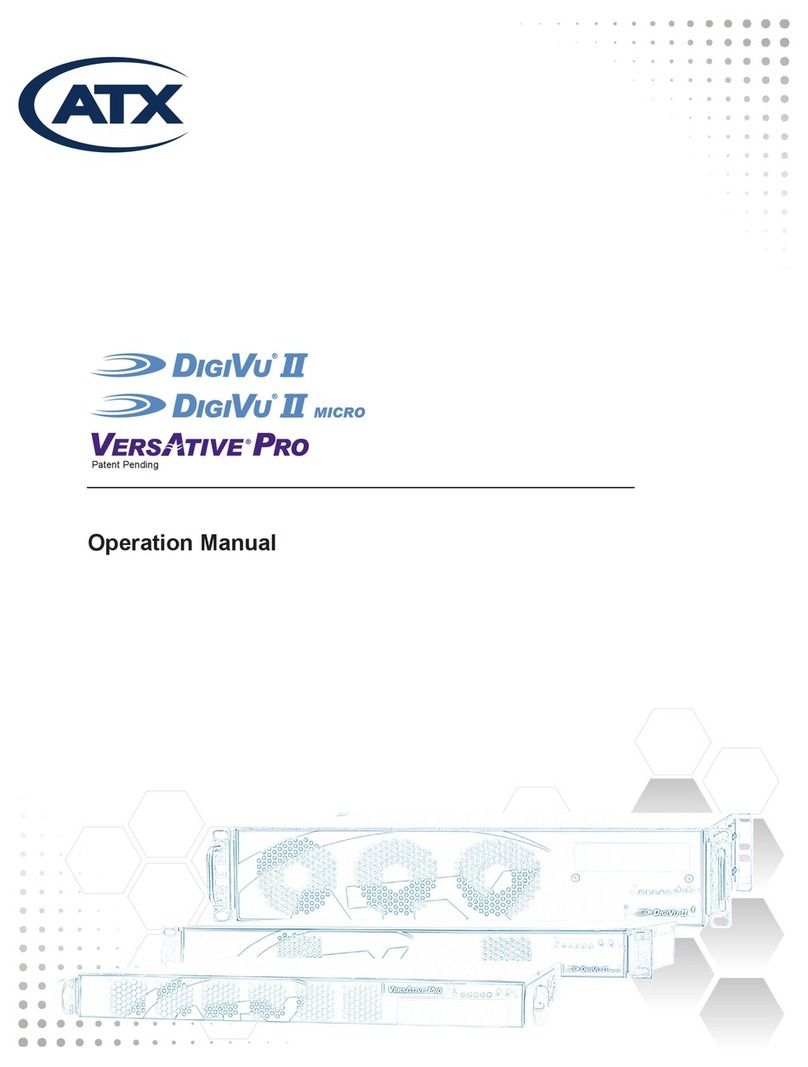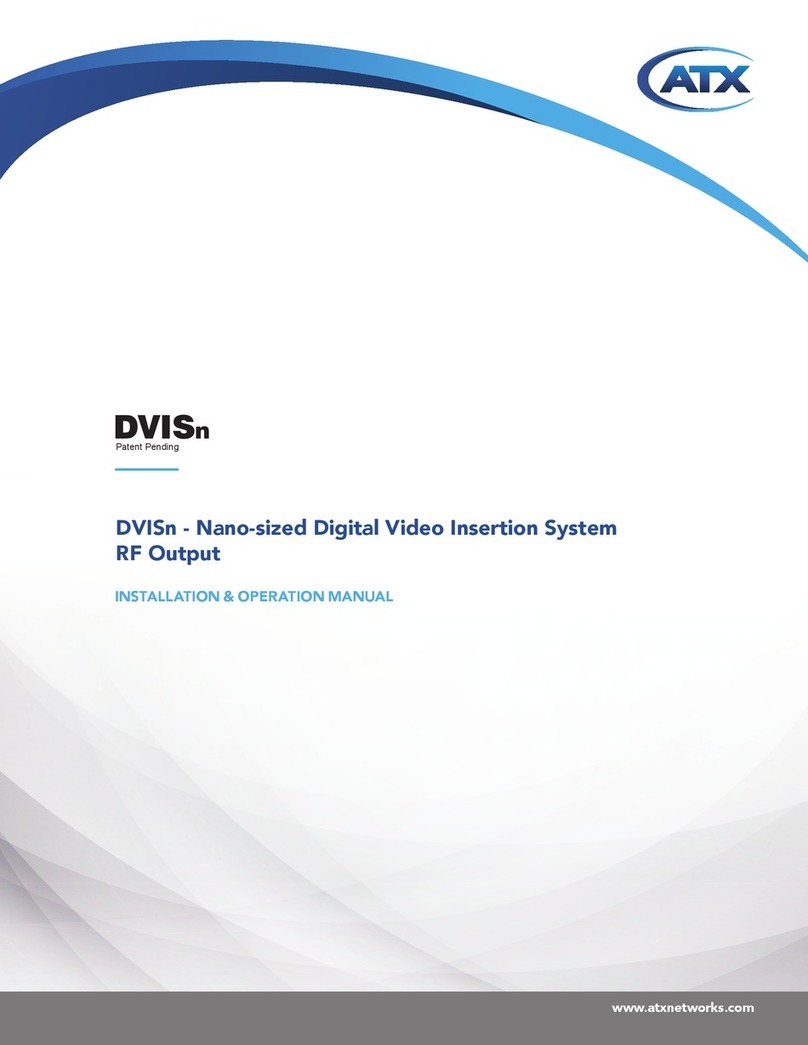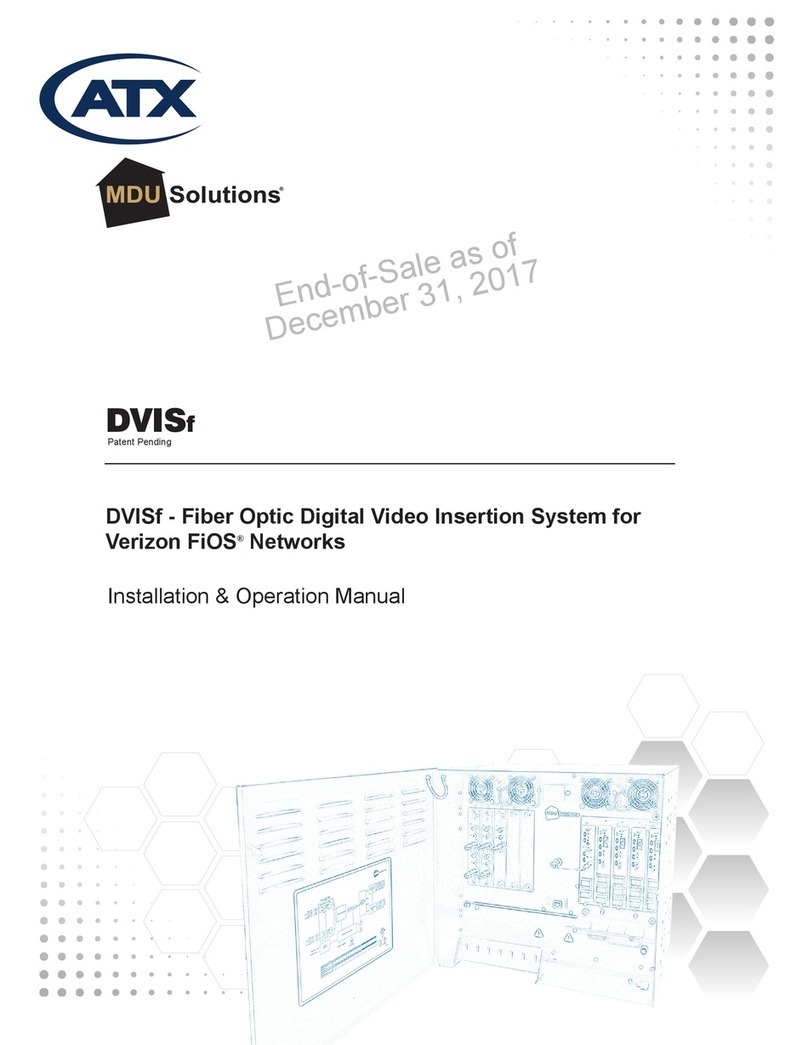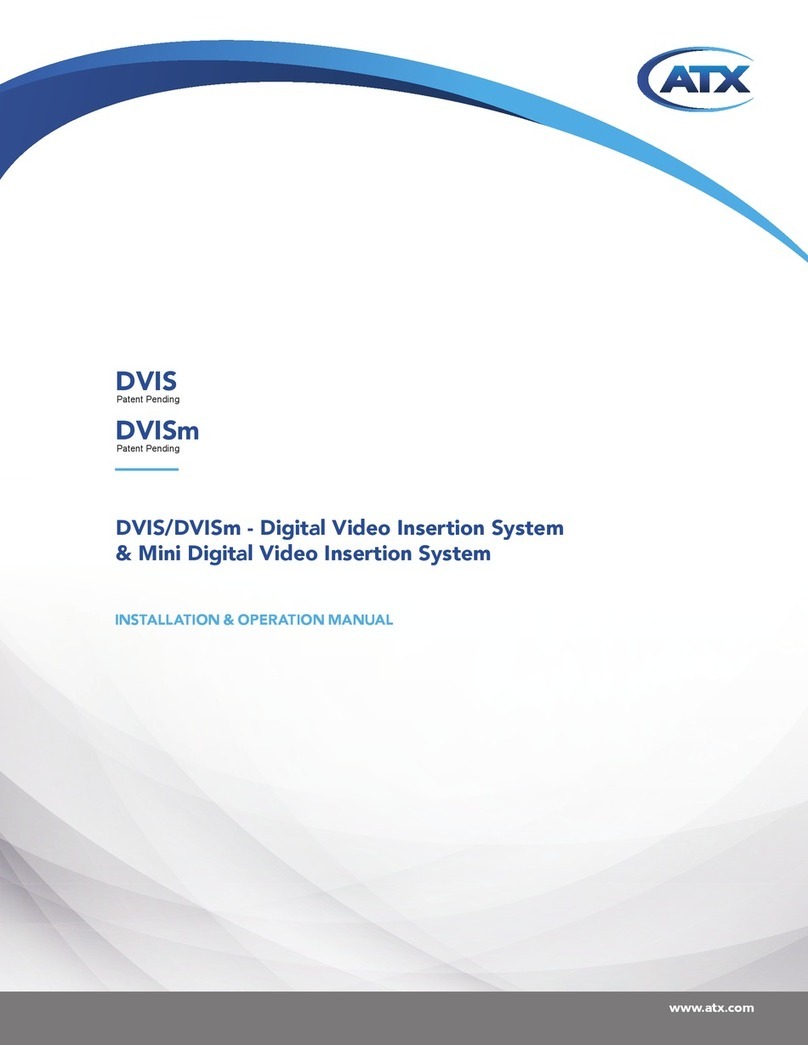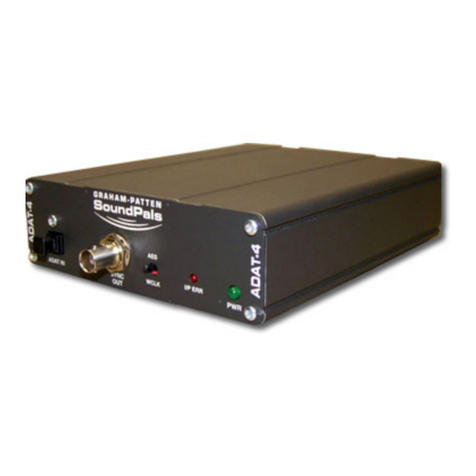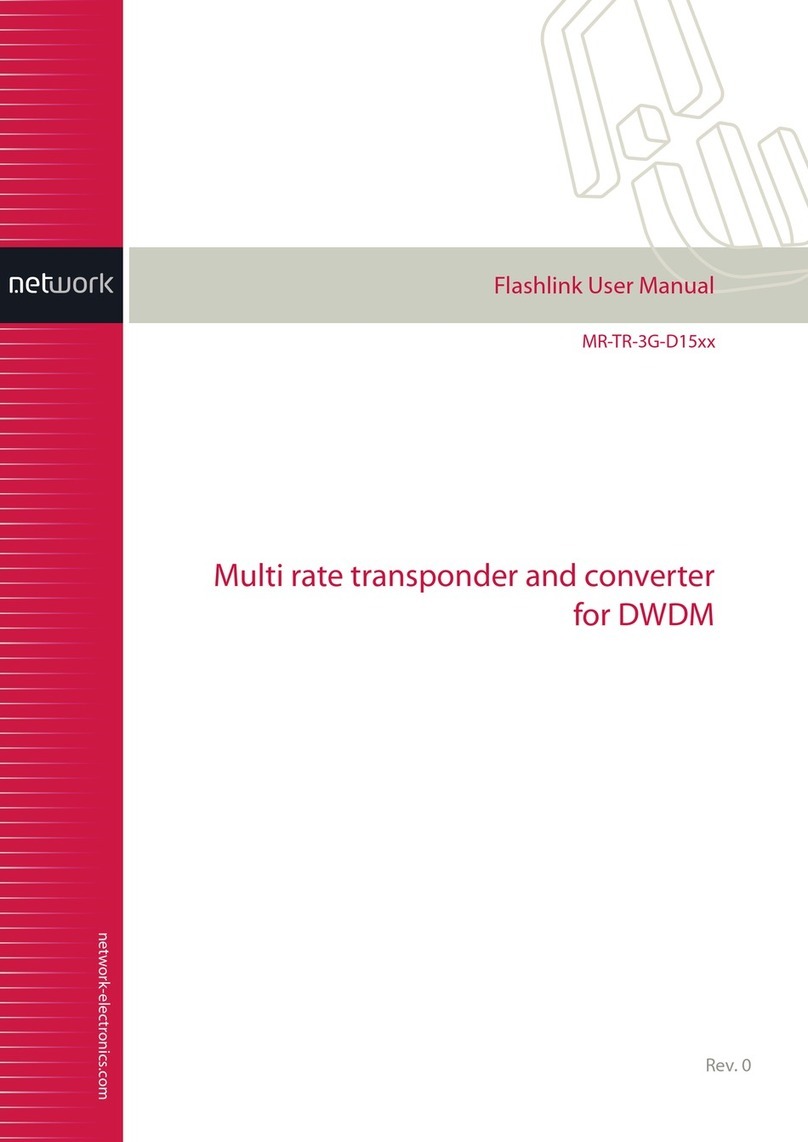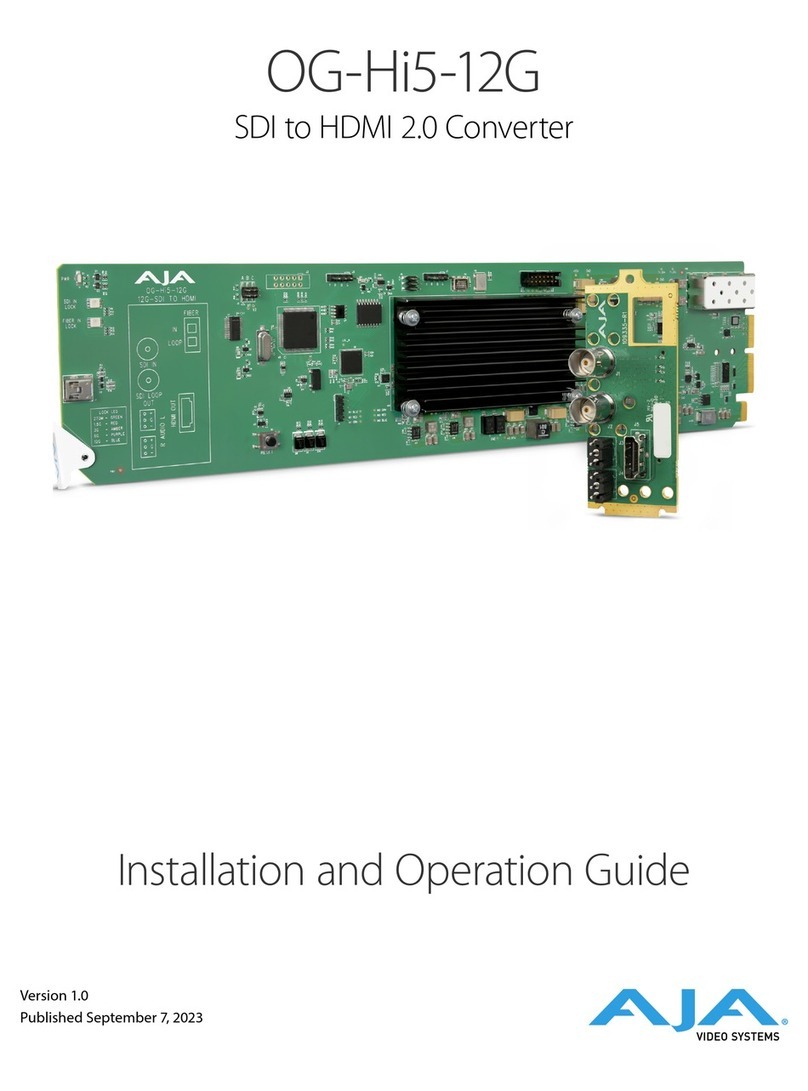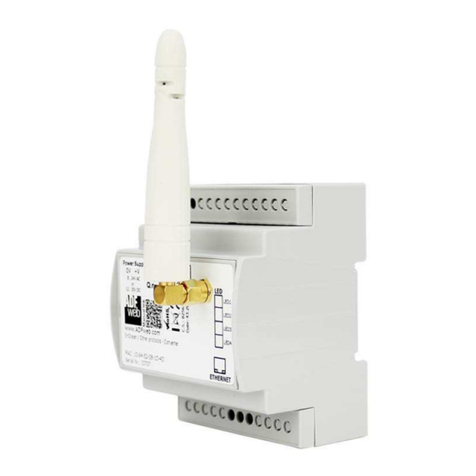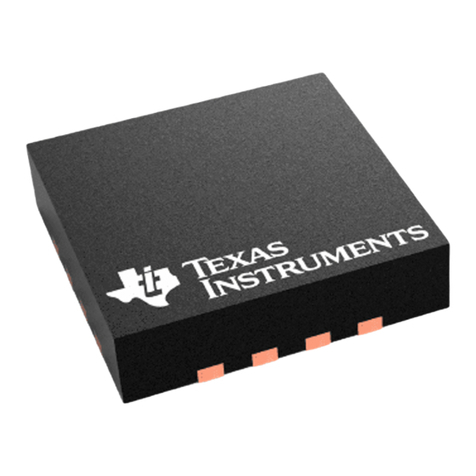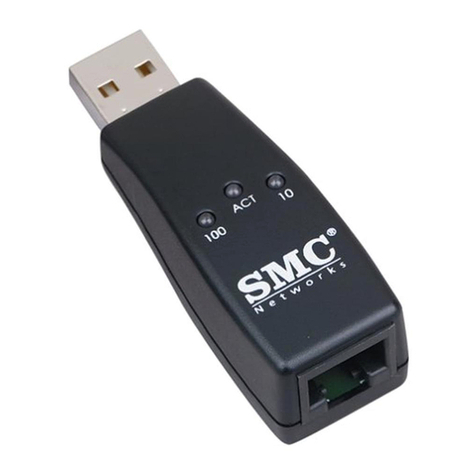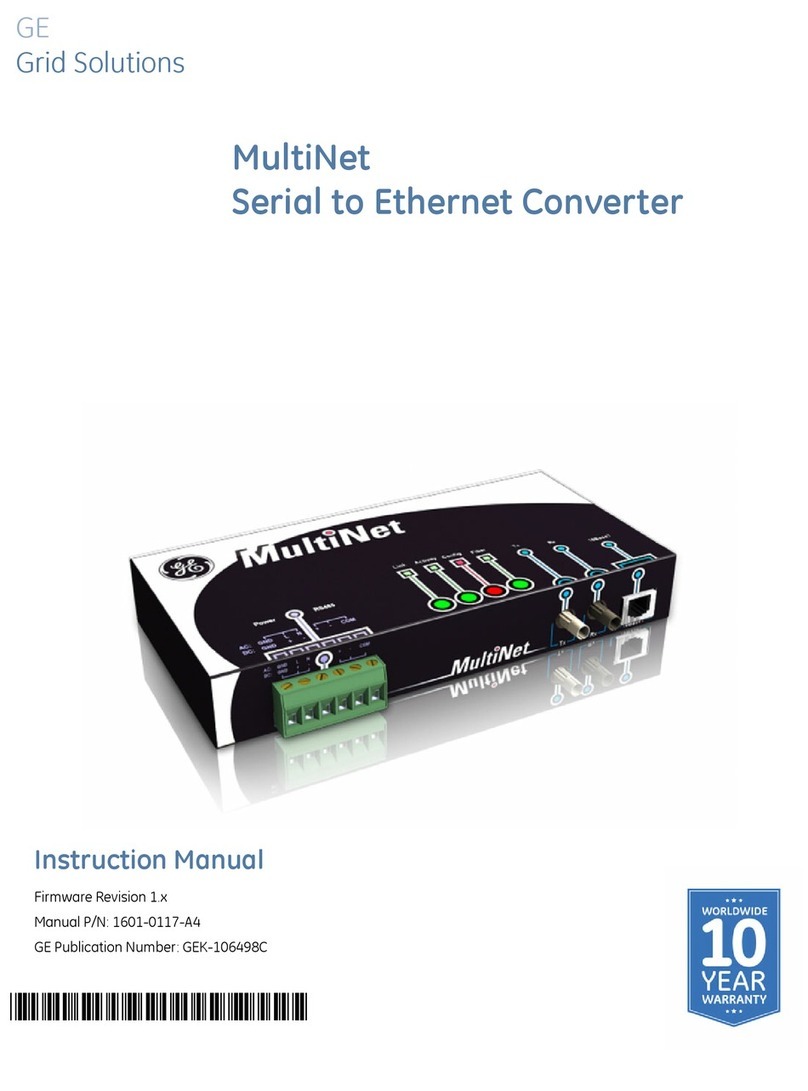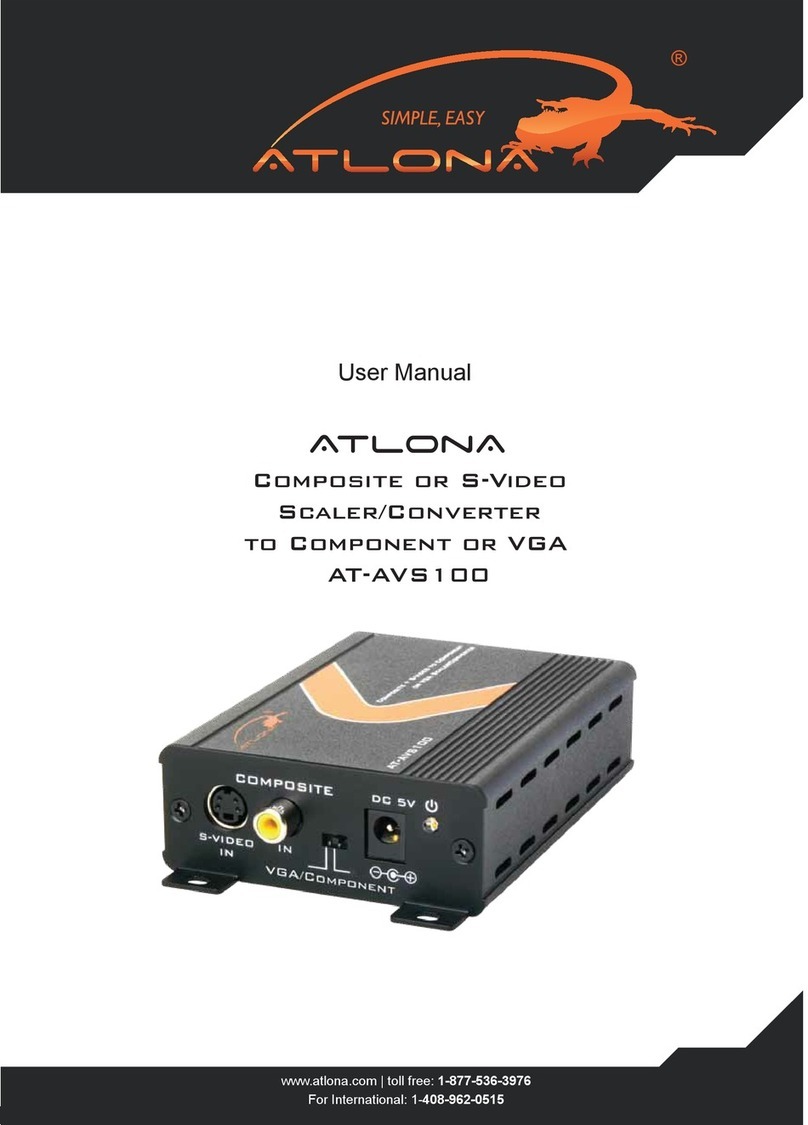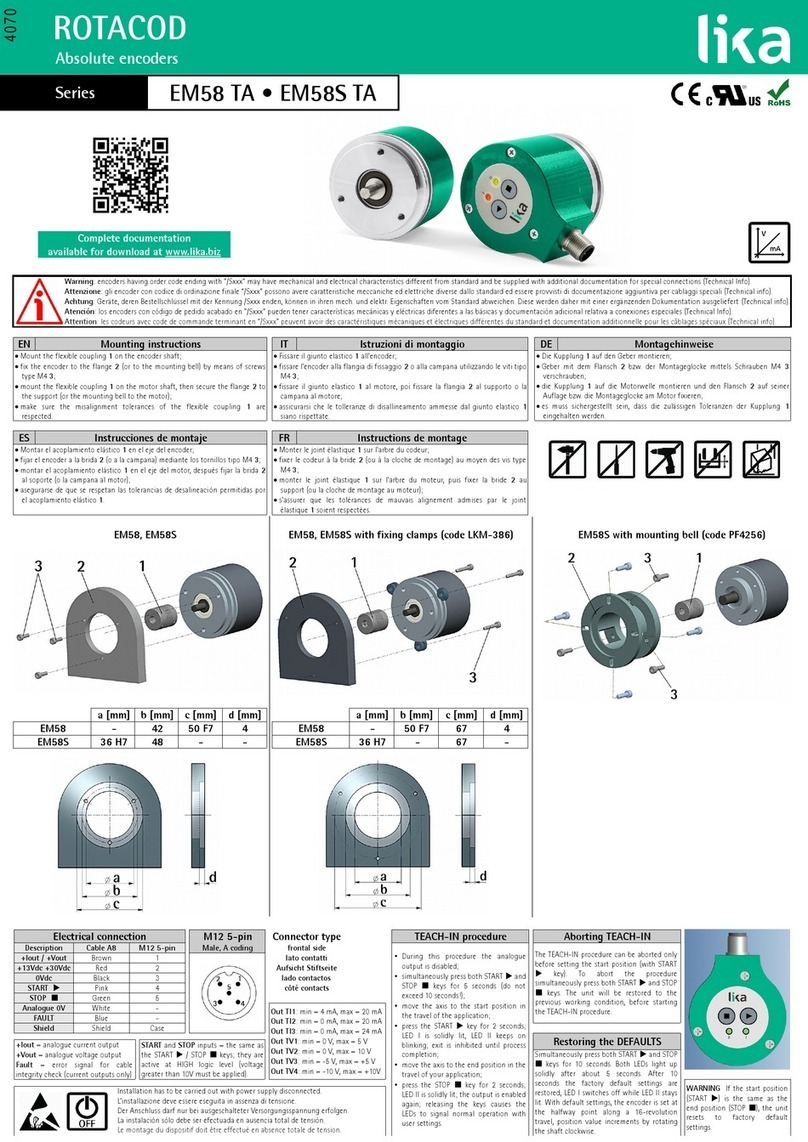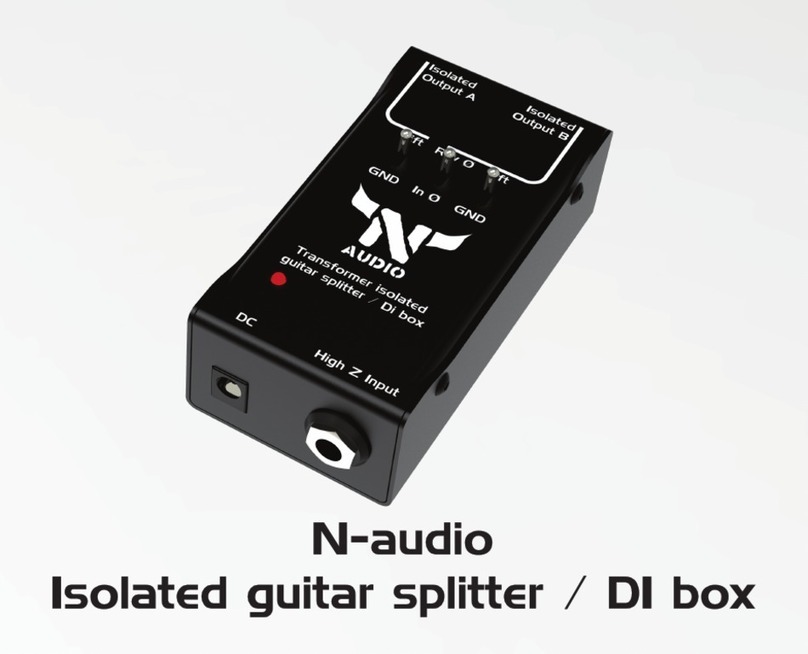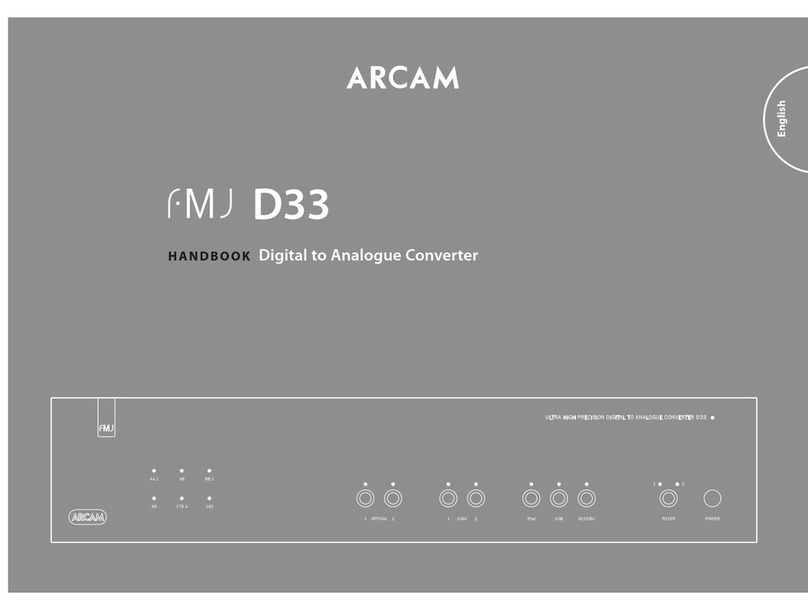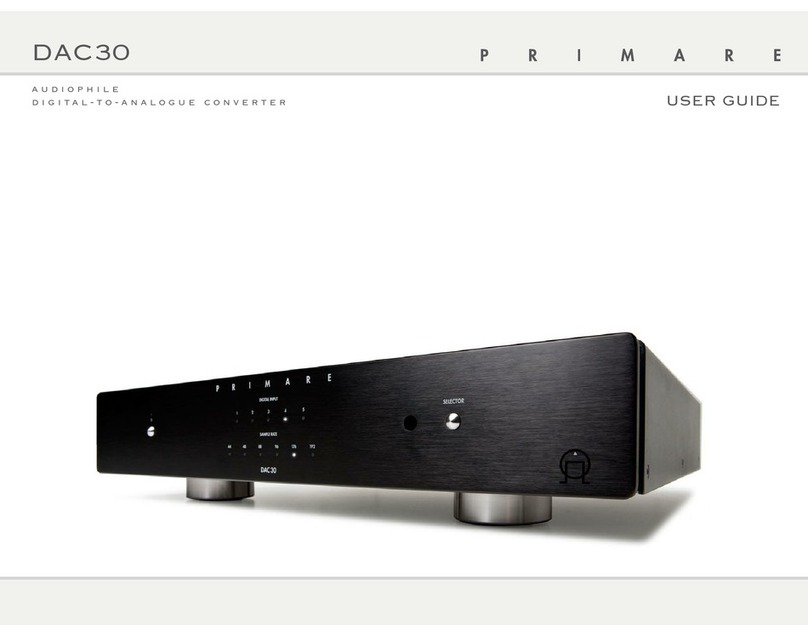ATX ivis User manual

IVIS - Indoor Video
Insertion System
Installation & Operation Manual
IVIS

Although every effort has been taken to ensure the accuracy of this document it may be necessary, without notice, to make amendments or correct omissions.
Specications subject to change without notice.
MDU Solutions®, UCrypt®, DigiVu®and VersAtive®Pro are registered trademarks of ATX in the United States and/or other countries. Products or features contained herein may be covered by one or
more U.S. or foreign patents. Adobe®Flash® Wikipedia®, and other non-ATX product and company names mentioned in this document are the property of their respective companies.

TABLE OF CONTENTS
Page
1. INTRODUCTION........................................................................................................................................ 1-1
2. INSTALLATION ......................................................................................................................................... 2-1
3. AGILE MODULATOR OPERATION .......................................................................................................... 3-1
3.1. Agile Modulator Front Panel Controls................................................................................................ 3-1
4. RF LEVEL ADJUSTMENT......................................................................................................................... 4-1
5. SERVICE & SUPPORT.............................................................................................................................. 5-1
5.1. Contact ATX Networks....................................................................................................................... 5-1
5.2. Warranty Information ......................................................................................................................... 5-1
5.3. Safety ................................................................................................................................................ 5-1
iMDU Solutions®– IVIS Indoor Video Insertion System - Instalation & Operation Manual i

Index of Figures
Figures
#1 IVIS Unit.......................................................................................................1-1
#2 Agile Modulator............................................................................................3-1
#3 Functional Schematic ..................................................................................4-1
ii MDU Solutions®– IVIS Indoor Video Insertion System - Instalation & Operation Manual

INTRODUCTION
1. Introduction
This document outlines the set-up and operation of the ATX Indoor Video/Audio Inserter System – IVIS.
The IVIS device takes ATX’s Channel Deletion Filters and integrates them with an agile or xed Video/Audio Modulator
packaged into an indoor housing. The IVIS device is mainly powered for powering the internal integrated Modulators.
The IVIS device allows the operator to delete one or two RF channels from the Cable TV spectrum and reinsert new
programming in Analog modulation format on those deleted channel locations. The new channels can be any Video/Audio
source such as a closed circuit Video Camera or a specialty service that has been demodulated to baseband Audio and
Video using a Set-Top-Box / Converter / Decoder. The latter example allows the operator to move specialty services from
higher tiers to the basic service.
The IVIS system can be ordered with xed or agile modulators. If xed modulators are ordered then their desired output
channel in the Cable TV spectrum has to be specied at time of order. For both modulator types (xed and agile) it has to be
specied at time of order whether the Cable TV channels are Standard, HRC, or IRC.
The RF channel deletion lter frequencies must be specied at time of order always for both modulator types as the lter is
not agile.
If an agile modulator is purchased, and the operator needs to change the channel to be deleted, only the channel deletion
lter must be replaced. The agile modulator will easily tune to the new channel where xed modulators need to be removed
from the IVIS chassis and replaced with a modulator that is tuned to the new channel number. The chassis is easily opened
and allows removal and replacement of the channel deletion lters and/or Video/Audio Modulators.
Each Video/Audio Modulator has one Audio and one Video Input. Those inputs are clearly marked beneath each modulator
on the IVIS device’s front panel. The Audio deviation, Video depth-of-modulation, RF Output level and Video/Audio Carrier
Ratio for each modulator can be adjusted from the modulator’s front panel.
Ensure that the Cable System’s Analog Video Carrier levels present at the IVIS device’s input port are between 4dBmV and
34dBmV. This ensures that the new inserted channels can be adjusted to the same Analog Video Carrier level as the rest of
the Cable TV spectrum Analog channels passing through the IVIS unit.
MDU Solutions®– IVIS Indoor Video Insertion System - Instalation & Operation Manual 1-1
CHAPTER 1: INTRODUCTION
Figure #1: IVIS Unit

1-2 MDU Solutions®– IVIS Indoor Video Insertion System - Instalation & Operation Manual
CHAPTER 1: INTRODUCTION
This page left intentionally blank.

INSTALLATION
2. Installation
The IVIS unit can be mounted in a 19” rack housing or another appropriate cabinet for secure operation. All RF and BaseBand
signal ports accept standard F connectors mounted on drop cables (RG-6/u, RG-11/u or similar).
Connect the incoming Cable TV feed to the INPUT port and connect the OUTPUT port to your distribution system. Connect
Video and Audio signals to one or both (if two Video/Audio sources present) Modulators. In case of an Agile Modulator ensure
that the Modulator Channel is set properly by checking the displayed Channel number on the Modulator’s front panel.
MDU Solutions®– IVIS Indoor Video Insertion System - Instalation & Operation Manual 2-1
CHAPTER 1: INTRODUCTION CHAPTER 2: INSTALLATION

CHAPTER 2: INSTALLATION
2-2 MDU Solutions®– IVIS Indoor Video Insertion System - Instalation & Operation Manual
This page left intentionally blank.

AGILE MODULATOR OPERATION
3. Agile Modulator Operation
The utilized modulators are high quality, vestigial sideband units with synthesized visual and aural carriers. The frequency
agile modulators allow front panel pushwheel switch selection of Standard, HRC or IRC Cable TV channels 2 through 135,
or VHF/UHF Broadcast TV channels 2 through 69. The Cable TV Channel Plan in use - Standard, HRC, or IRC – has to be
determined at time of ordering.
The heterodyne conversion system, in conjunction with the use of a SAW lter, ensures optimum vestigial selectivity for
adjacent channel operation.
The modulator is designed to accept any standard audio/video source such as NTSC video and audio baseband signals from
a satellite receiver, TV camera, videotape recorder, TV demodulator, Cable Set Top Box Converter, or similar signal source.
The modulator is designed to accept standard (negative sync) polarity video at nominal 1 V p-p level.
All level controls are located on the front panel for ease of operation.
The modulator’s maximum RF Output level at IVIS Output connector is +33 dBmV and is adjustable over a 10 dB range on
the modulator front panel by using RF Output Level control, and is adjustable an additional 20 dB by utilizing the common
front panel attenuator.
3.1. Agile Modulator Front Panel Controls
POWER/ERROR Indicator
Lights when the unit is powered. A ashing condition indicates an invalid channel setting or other
conditions that would cause the unit to operate on an invalid channel. The RF output is switched
OFF for ashing (ERROR) conditions.
AUDIO Level Control
The setting of this screwdriver adjustment determines the aural carrier deviation. Clockwise rotation
increases the carrier deviation.
VIDEO Level Control
The setting of this screwdriver adjustment determines the video modulation level. Clockwise rotation
increases the modulation depth.
Channel Number Switch
Sets the desired operating channel for Cable TV channels 2 through 135, or Broadcast TV channels
2 through 69.
Mode Switch
Sets the type of channel, Cable TV (CATV) or Broadcast TV (BCTV). The rst left position of the
switch (CATV +100) sets a leading “1” FOR Cable TV channels 100 through 135.
A/V Ratio Control
This screwdriver adjustment varies the level of the aural carrier over a range from 12 to 22 dB below
the visual carrier. The aural carrier should be adjusted to approximately 15 dB below the visual
carrier (normal operation). Clockwise rotation increases the aural carrier level.
RF Output Level
This screwdriver adjustment permits decreasing the RF output level a maximum of 10 dB as the
control is rotated counterclockwise.
CAUTION: USE AN INSULATED SCREWDRIVER BLADE WHEN ADJUSTING THE AUDIO,
VIDEO, A/V, OR RF ADJUSTMENTS. THIS WILL PREVENT THE POSSIBILITY OF SHORTING
CIRCUITRY TO THE FRONT PANEL IN THE EVENT THAT THE SCREWDRIVER SLIPS OUT OF
THE SLOT IN THE PLASTIC SHAFT OF THE POTENTIOMETER.
MDU Solutions®– IVIS Indoor Video Insertion System - Instalation & Operation Manual 3-1
CHAPTER 3: AGILE MODULATOR OPERATIONCHAPTER 2: INSTALLATION
Figure #2: Agile Modulator

3-2 MDU Solutions®– IVIS Indoor Video Insertion System - Instalation & Operation Manual
CHAPTER 3: AGILE MODULATOR OPERATION
This page left intentionally blank.

RF LEVEL ADJUSTMENT
4. RF Level Adjustment
Once you have connected the INPUT and OUTPUT ports to respectively the incoming Cable Feed and the Distribution
System, as well as Audio and Video Source Signals to corresponding Modulator Audio and Video Inputs, while monitoring the
signal level at the IVIS -20 dB RF OUT TEST Point with a Spectrum Analyzer or RF Signal Level Meter, you should be able
to measure the new Modulator’s Video and Audio carrier levels as well as the Video carrier levels for Analog signals or QAM
Power Levels for Digital signals of the existing cable system’s adjacent channels.
While monitoring the meter or analyzer, adjust the Modulator’s Video Carrier Levels by adjusting the common attenuator on
the front of the IVIS unit until you obtain an equal level as the adjacent Cable system’s Analog channel Video Carrier Level,
or 6 dB higher than the adjacent 256QAM Digital signal Power Level or 10 dB higher than the adjacent 64QAM Digital signal
Power Level. If you require additional and/or ner RF Output Level adjustment for either of the two modulators mounted in the
IVIS, adjust the RF Output Level potentiometer on the front panel of the Modulator as described in previous section.
From the factory the modulator front panel RF Output Level potentiometer is set to maximum RF output level, this will give
you the best Signal to Noise Ratio. Always attempt to make all Video Carrier Level adjustments using the common attenuator
on the IVIS front panel.
Verify that the Modulator’s Audio carrier is 15 dB below the Video Carrier. If not adjust the A/V potentiometer on the Modulator’s
front panel until the Audio to Video Ratio is set to -15 dB.
All previous measurements are to be done using a spectrum analyzer or RF signal level meter.
If using Spectrum Analyzer for measuring Analog and Digital RF Signals: Be sure to have taken into account RBW settings
and have made corrections to the Spectrum Analyzers Reading while measuring Digital QAM Signals. Make use of Band
Power Measurement option for measuring Digital QAM signals, if supported by Spectrum Analyzer.
If using RF Signal Level Meter for measuring Analog and Digital RF Signals: Be sure to have selected the correct
measurement mode for measuring Analog and Digital Signals.
After RF level adjustment is nished, the Video Carrier Levels of the inserted one or two new Analog signals shall equal the
Video Carrier Levels of the Cable system’s existing adjacent Analog signals Video Carriers or be 6 dB higher than adjacent
256QAM signals or be 10 dB higher than adjacent 64QAM signals.
If required, set the Audio deviation by adjusting the AUDIO potentiometer on the front panel of the modulator as described in
previous section. Also, if required, set the VIDEO Modulation depth by adjusting the VIDEO potentiometer on the front panel
of the modulator as described in previous section.
MDU Solutions®– IVIS Indoor Video Insertion System - Instalation & Operation Manual 4-1
CHAPTER 3: AGILE MODULATOR OPERATION CHAPTER 4: RF LEVEL ADJUSTMENT
Figure #3: Functional Schematic
FI
L
TER
1
FI
L
TER
2
-20 dB
TEST
POINT
VIDEO IN 1
AUDIO IN 1
VIDEO IN 2
AUDIO IN 2
COMBINER
MODULATOR 1
POWER SUPPLY
100-240 V
AC IN
RF IN
RF OUT
CHANNEL DELETION FILTERS
DIRECTIONAL
COUPLER
INDOOR VIDEO INSERTION SYSTEM
MODULATOR 2
VARIABLE
ATTENUATOR

CHAPTER 4: RF LEVEL ADJUSTMENT
4-2 MDU Solutions®– IVIS Indoor Video Insertion System - Instalation & Operation Manual
This page left intentionally blank.

SERVICE & SUPPORT
5. Service & Support
5.1. Contact ATX Networks
Please contact ATX Technical Support for assistance with any ATX products. Please contact ATX Customer Service to obtain
a valid RMA number for any ATX products that require service and are in or out-of-warranty before returning a failed module
to the factory.
DIGITAL VIDEO TECHNICAL SUPPORT
Tel: (905) 428-6068
Toll Free: (800) 565-7488 (USA & Canada only)
► Press *3 for Technical Support
►Then press 1 for Digital Video Products (DVIS, DigiVu, UCrypt, VersAtivePro, VMS, DigiStream)
Email: [email protected]
CUSTOMER SERVICE
ATX Networks
1-501 Clements Road West
Ajax, ON L1S 7H4 Canada
Tel: (905) 428-6068
Toll Free: (800) 565-7488 (USA & Canada only)
► Press *1 for Customer Service
Fax: (905) 427-1964
Toll Free Fax: (866) 427-1964 (USA & Canada only)
Web: www.atxnetworks.com
Email: [email protected]
5.2. Warranty Information
All of ATX Networks’ products have a 1-year warranty that covers manufacturer’s defects or failures.
5.3. Safety
IMPORTANT! FOR YOUR PROTECTION, PLEASE READ THE FOLLOWING:
WATER AND MOISTURE: Care should be taken so that objects do not fall and liquids are not spilled into the enclosure
through openings.
POWER SOURCES: The device should be connected to a power supply only of the type described in the operating instructions
or as marked on the device.
GROUNDING OR POLARIZATION: Precautions should be taken so that the grounding or polarization means of the device
is not defeated.
POWER CORD PROTECTION: Power supply cords should be routed so that they are not likely to be pinched by items
placed upon or against them, paying particular attention to cords at plugs, convenience receptacles, and the point where
they exit from the device.
SERVICING: The user should not attempt to service the device beyond that described in the operating instructions. All other
servicing should be referred to qualied service personnel.
FUSING: If your device is equipped with a fused receptacle, replace only with the same type fuse. Refer to replacement text
on the unit for correct fuse type.
MMDU Solutions®– IVIS Indoor Video Insertion System - Instalation & Operation Manual 5-1
CHAPTER 5: SERVICE & SUPPORTCHAPTER 4: RF LEVEL ADJUSTMENT

Printed in Canada Rev. 04/16 (ANW0781)
1-501 Clements Road West, Ajax, ON L1S 7H4 Canada
Tel +1 (905) 428-6068 Toll Free +1 (800) 565-7488
Fax +1 (905) 427-1964 Toll Free Fax +1 (866) 427-1964
www.atxnetworks.com [email protected]
Table of contents
Other ATX Media Converter manuals
